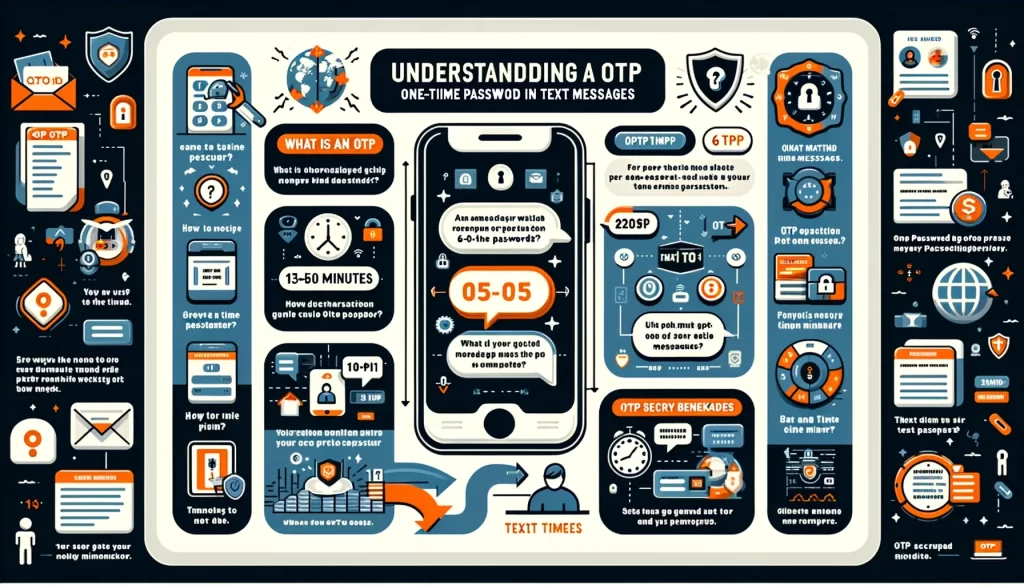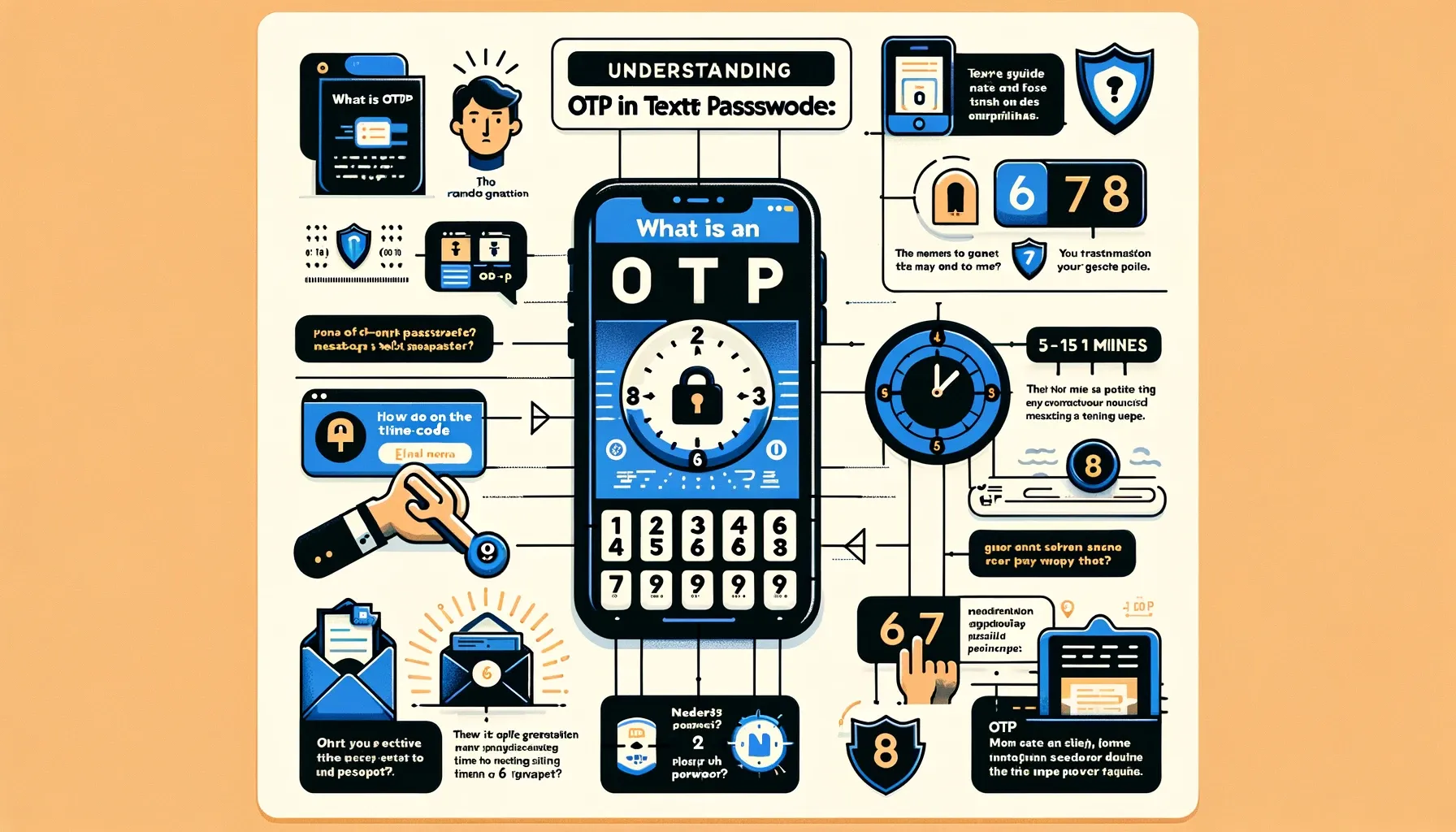Are you wondering about the meaning of OTP in Text messages? This post explains how one-time passwords work when you receive SMS OTP codes, expiration times, security benefits, proper usage, and how OTP verification enhances account protection.
Have you ever received a Text message containing a random 6-digit OTP code and need clarification about what it means and why you’re getting it? OTP stands for one-time passwords and is commonly used for identity verification and security. In this guide, we’ll explain the meaning of OTP in Text, how they work, and when you can expect to receive OTP codes via SMS.
What is an OTP?
OTP is short for a one-time password. It refers to a temporary numeric passcode that is randomly generated and expires after one use. OTPs primarily confirm someone’s identity and authorize sensitive account transactions or activities.
Since OTPs are unique, time-limited numbers that can’t be reused, they offer a convenient method of heightened security beyond standard static passwords. That’s why you’ll commonly get texted OTP codes from banks, online services, and other providers needing to verify your identity remotely.
Read also: Amazon Return After the Window Closed

What is OTP Meaning in Text?
| Attributes | Meaning |
|---|---|
| Term | OTP |
| Stands For | One-Time Password |
| Format | 6-digit numeric code |
| Delivery Method | Text message (SMS) |
| Purpose | Identity verification and authorization |
| Expiration | Typically 3-15 minutes |
| Examples Uses | Bank logins, transactions, account security |
| Security Benefits | Random, single-use, time-limited |
| User Actions | Enter OTP when requested, don’t share codes |
How Do OTP Text Messages Work?
The basic process behind OTP text messages is:
- You initiate an activity requiring identity confirmation (like logging into a mobile banking app).
- The service provider automatically sends a random 6-digit OTP code to your registered mobile number.
- You enter the received OTP to authenticate the action before the code expires.
- The verified OTP grants one-time access or approval just for that instance.
The automated nature of generating and texting OTP codes makes this a seamless way to confirm identities without cumbersome callbacks or email approvals. And the one-time use means even intercepted codes can’t be exploited.
When Are OTP Text Messages Sent?
Some common scenarios when you may receive a 6-digit OTP code via text message include:
- Logging into a mobile banking or financial app
- Authorizing large bank account transactions
- Making an online purchase with extra security
- Resetting an account password or username
- Verifying your identity to access medical records
- Authenticating a tax filing or government service
- Confirming a payment or money transfer
- Validating travel reservations or ticket purchases
Anytime heightened security is needed for account login, financial transaction, or identity confirmation, sending an OTP text is a standard verification technique.
Examples of OTP Text Message Content
OTP text messages will look something like this:
“Your OTP for accessing your AnyBank account is 123456. This code will expire in 10 minutes.”
“Here is your one-time password from OnlineShoppingWebsite: 849205”
“Use this OTP to confirm your $5000 wire transfer: 753481. Reply STOP to cancel the transaction.”
The content provides context around the specific action requiring identity confirmation using the 6-digit OTP code. Time sensitivities and expiration info are often included too.
OTP Security Benefits
OTP text messages provide stronger security than traditional passwords in several key ways:
- Randomly generated codes are unpredictable, and not reused.
- Limited lifespan renders intercepted OTPs worthless.
- No need to memorize or store passcodes.
- OTPs are tied and traceable to specific transactions.
- The automated nature avoids reliance on recall or messy callbacks.
- Convenient text delivery enables ubiquitous identity confirmation.
For these reasons, OTPs via SMS offer an air-tight verification technique that enhances security without overburdening users.
OTP Expiration Timeframes
Most 6-digit OTP codes expire rapidly for maximum security. Here are some common OTP validity durations:
- 3-5 minutes – Gives users a short window to input the OTP.
- 10-15 minutes – A little more time for OTPs needed in complex flows.
- 1 hour – In cases where immediacy isn’t critical, OTPs may last an hour.
- 24 hours – For OTPs granting access on an ongoing basis, 24-hour windows are common.
The shorter the expiry, the more tightly it restricts the OTP’s viability for fraudulent reuse. But very short windows under 3 minutes can disrupt user experiences. 15 minutes is a typical optimum OTP lifespan.
Bypassing OTP Authentication Requests

When you receive an OTP text you weren’t expecting, it’s fine to ignore it if you don’t initiate the related activity. The OTP will simply expire unused. The authentication request will fail gracefully without the valid OTP.
However, if you requested the OTP for a legitimate purpose like a password reset or transaction approval, make sure to complete the verification promptly before the OTP expires. Otherwise, you may get locked out of the account or need to repeat identity confirmation steps.
OTP Security Precautions
To use OTPs safely:
- Never share OTP codes with anyone, under any circumstances.
- Use secure messaging apps for OTP texts to protect against interception.
- Avoid OTP delivery to compromised devices or numbers.
- Delete texts immediately after using OTPs.
- Alert providers if you receive any suspicious or unsolicited OTP texts.
Following basic precautions helps ensure OTPs enhance your security rather than open new attack vectors.
The Evolution of OTP Identity Verification
OTP verification via SMS has grown rapidly in adoption as more services move online and demand for heightened security intensifies. One-time passcodes now play a central role in identity confirmation across finance, government, healthcare, and more.
With threats like social engineering, phishing, and password theft constantly evolving, OTPs provide the dynamic protections needed to validate identities remotely while preventing past codes from being exploited. And the automated nature of text messages enables seamless user experiences.
OTPs – Convenient and Secure
In summary, receiving a random 6-digit OTP code by text is simply an indication that an account or provider needs to confirm your identity before allowing access or approving a sensitive transaction. By entering OTPs when requested, you can securely authenticate important activities.
OTP text messages promote air-tight security through their randomized, ephemeral nature when used properly. Next time you get an unfamiliar OTP code, you can verify the source and confidently provide the time-limited passcode to authorized requestors. Understanding OTP meaning and proper usage is key to leveraging their powerful protections.

